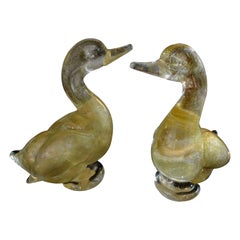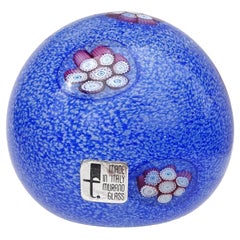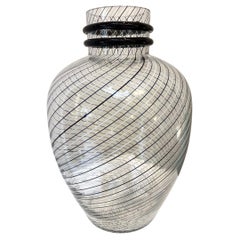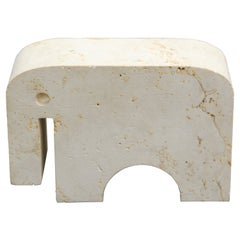Fratelli Animal Sculptures
to
1
1
1
1
1
1
1
1
1
1
1
Height
to
Width
to
1
1
1
4
126
106
103
71
Creator: Fratelli
Pair of Murano Glass Ducks by Fratelli
By Fratelli Toso, Barovier, Salviati, Fratelli, Seguso
Located in Houston, TX
Pair of Murano glass ducks by Fratelli.
Beautiful pair of gold murano glass ducks by Fratelli. This lovely pair of murano glass ducks are a gold gl...
Category
1940s Italian Hollywood Regency Vintage Fratelli Animal Sculptures
Materials
Blown Glass, Murano Glass
$995 / set
Related Items
Fratelli Toso Murano Blue Purple Flowers Glass Italian Art Glass Paperweight
By Fratelli Toso
Located in Kissimmee, FL
Beautiful vintage Murano hand blown royal blue and white mini spots, with purple and white millefiori flower murrines Italian art glass paperweight. Documented to the Fratelli Toso c...
Category
Mid-20th Century Italian Mid-Century Modern Fratelli Animal Sculptures
Materials
Glass, Art Glass, Blown Glass, Murano Glass, Murrine
$520 Sale Price
20% Off
H 2.75 in Dm 3 in
Murano Glass Vase by Fratelli Toso, 1980s
By Fratelli Toso
Located in Brussels, BE
Murano Glass Vase by Fratelli Toso, 1980s
Category
1980s Italian Mid-Century Modern Vintage Fratelli Animal Sculptures
Materials
Murano Glass
Murano Glass Bird of Paradise Peacock Pheasant Alfredo Barbini Salviati Cenedese
By Salviati, Alfredo Barbini
Located in Palm Beach, FL
An elegant murano glass bird of paradise sculpture, may also be described as a peacock or pheasant, by Alfredo Barbini for Salviati and C...
Category
Mid-20th Century Italian Hollywood Regency Fratelli Animal Sculptures
Materials
Glass, Art Glass, Blown Glass, Murano Glass, Sommerso
$1,365 Sale Price
30% Off
H 13 in W 7 in D 4.5 in
Large Scale Vintage Murano Glass Duck Bird Figurine Sculpture Dino Martens
By Barovier, Venini, Seguso, Fratelli Toso, Dino Martens
Located in Bad Säckingen, DE
This is a large, massive duck sculpture from the 1950s made in the Sommerso and mezza filigrana technique. It is a decorative piece and was likely designed by Dino Martens for Fratel...
Category
1950s Italian Mid-Century Modern Vintage Fratelli Animal Sculptures
Materials
Glass, Art Glass, Blown Glass
$748 Sale Price
20% Off
H 10.83 in W 13.39 in D 3.94 in
Set of 3 Murano Ducks
Located in Los Angeles, CA
Set of 3 vintage hand blown Murano glass ducks infused with gold flecks, with Swarovski crystal eyes / Made in Italy, circa 1980s
"Murano Glass" etc...
Category
Late 20th Century Italian Modern Fratelli Animal Sculptures
Materials
Murano Glass
Vintage Murano Glass Fish Decorative Figurine by Fratelli Toso, Italy
By Fratelli Toso
Located in Bresso, Lombardy
Murano, Italy, 1950s.
This fish is made in polychromed hand-blown Murano glass.
It is a vintage piece, therefore it might show slight traces of use, but it can be considered as in p...
Category
1950s Italian Mid-Century Modern Vintage Fratelli Animal Sculptures
Materials
Murano Glass
$399 Sale Price
28% Off
H 5.91 in W 9.45 in D 2.17 in
Gold, Clear Murano Glass Shark by Barovier
By Barovier
Located in New York, NY
Mid Century gold Murano glass shark on clear glass stylized rock base. Barovier, Italy.
Category
Mid-20th Century European Mid-Century Modern Fratelli Animal Sculptures
Materials
Murano Glass
Two Murano Ducks Glass 24 Carat Gold, 1980s
By Vintage Murano Gallery
Located in Den Haag, NL
Two adorable little ducks. Made by Murano, Italy, 1980s. Hollywood Regency style.
Chrystal glass with 24-carat gold. Very nice set. Excellent condition.
Category
1980s Italian Hollywood Regency Vintage Fratelli Animal Sculptures
Materials
Crystal
Archimede Seguso Pair of Murano Glass Animal Sculptures of Black & White Ducks
By Archimede Seguso
Located in London, GB
A pair of black and white animal sculptures by Archimede Seguso (1909-1999) Italy made circa 1970 comprising of two large ducks, in solid opaque...
Category
1970s Italian Mid-Century Modern Vintage Fratelli Animal Sculptures
Materials
Art Glass, Blown Glass, Murano Glass
$1,377 / set
H 10.63 in W 11.03 in D 5.91 in
Murano glass paste snail, Seguso style, Nason Zuccheri
By Barovier, Toni Zuccheri, Seguso, Napoleone Martinuzzi, Salviati
Located in Lugo, IT
Murano glass paste snail, Seguso Nason Zuccheri style.
Good condition.
Thank you.
Category
1970s Italian Organic Modern Vintage Fratelli Animal Sculptures
Materials
Murano Glass
Fratelli Toso Murano Rainbow Pattern Gold Fleck Italian Art Glass Duck Sculpture
By Fratelli Toso, Aureliano Toso
Located in Kissimmee, FL
Beautiful, rare, and large, vintage Murano hand blown multi-color filigrana stripe ribbons with gold accents Italian art glass duck bird sculpture. Created in the manner of the Frate...
Category
Mid-20th Century Italian Mid-Century Modern Fratelli Animal Sculptures
Materials
Gold Leaf
$1,350
H 6.5 in W 3.25 in D 10.5 in
Murano Sommerso Duck in Alexandrite Glass, Attributed to Fratelli Toso, 1960s
By Fratelli Toso
Located in Glasgow, GB
A vintage Murano glass duck sculpture, attributed to the furnace of Fratelli Toso, and likely produced for export during the 1960s. Formed using the sommerso technique, a vibrant red...
Category
Mid-20th Century Italian Mid-Century Modern Fratelli Animal Sculptures
Materials
Murano Glass
$475
H 9.06 in W 3.15 in D 3.94 in
Previously Available Items
Travertine Elephant by Fratelli Mannelli for Raymor Signed
By Fratelli Manelli, Raymor, Fratelli
Located in Moreno Valley, CA
Vintage textured travertine elephant by Fratelli Mannelli for Raymor,
Collectible vintage hand carved travertine elephant by Fratelli Mannelli for Raymor.
Vintage abstract Fratell...
Category
Mid-20th Century Italian Post-Modern Fratelli Animal Sculptures
Materials
Travertine
Fratelli animal sculptures for sale on 1stDibs.
Fratelli animal sculptures are available for sale on 1stDibs. These distinctive items are frequently made of murano glass and are designed with extraordinary care. There are many options to choose from in our collection of Fratelli animal sculptures, although brown editions of this piece are particularly popular. Many of the original animal sculptures by Fratelli were created in the Hollywood Regency style in italy during the 1940s. If you’re looking for additional options, many customers also consider animal sculptures by Mauro Manetti, and Malevolti. Prices for Fratelli animal sculptures can differ depending upon size, time period and other attributes — on 1stDibs, these items begin at $995 and can go as high as $995, while a piece like these, on average, fetch $995.
Questions About Fratelli Animal Sculptures
- Who was Fratelli Toso?1 Answer1stDibs ExpertApril 5, 2022Fratelli Toso was a glass manufacturer based in Murano, Italy. The Toso Brothers, Angelo, Giovanni, Ferdinando, Carlo, Gregorio and Liberato, founded the company in 1854. You'll find a range of Fratelli Toso decorative objects from some of the world’s top sellers on 1stDibs.
- 1stDibs ExpertAugust 29, 2024The history of Fratelli Toso begins in 1854, when the six Toso brothers and their father, Pietro, founded a glassworks on the island of Murano in Italy. Early on, the company focused on producing practical glassware, such as apothecary jars. However, within 10 years, it was producing more ornamental pieces like chandeliers. Following Pietro's death in 1862, his sons took control of the business. In the early 20th century, the glassworks started to focus on manufacturing art glass, selling under the name Antica Vetreria Fratelli Toso. During World War I, the company temporarily relocated to Liverno and then resumed operations in Murano in 1924. Later in the 20th century, Pietro's sons assumed ownership of the company. After facing economic hardships and internal disputes in the 1970s, the company was divided into Antica Vetreria Fratelli Toso and Fratelli Toso International. The latter company closed in 1981 due to bankruptcy, but Antica Vetreria Fratelli Toso continues to produce Murano glass today under the guidance of Pietro's descendants. On 1stDibs, shop a range of Fratelli Toso art glass.



